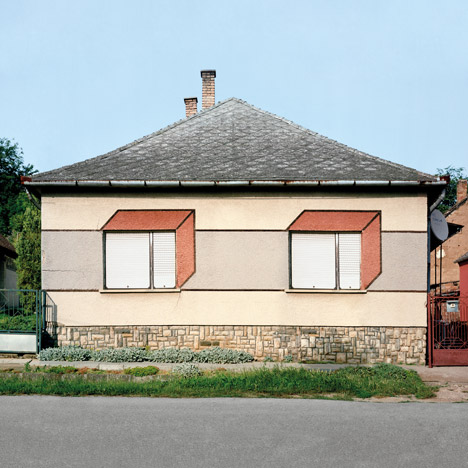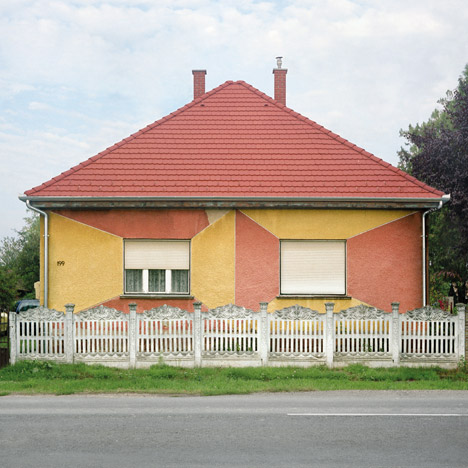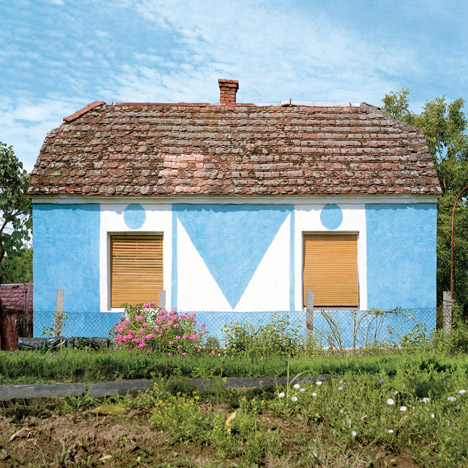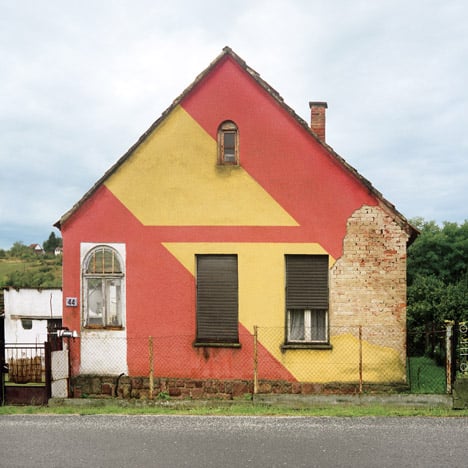Hungarian Cubes: the houses of post-war communism photographed by Katharina Roters
Photo essay: German-Hungarian artist Katharina Roters has produced a series of photographs documenting the ornamental patterns added to standardised dwellings in Hungary as an expression of individuality (+ slideshow).
The Hungarian Cube is a regimented type of home dating back to the 1920s, which can be found in many of the country's towns and suburbs. The buildings have become closely identified with post-war communism, and were often decorated by residents, creating an inadvertent protest against standardisation.
Roters was initially attracted to the geometric patterns, but came to realise that the "Kadar cube" – nicknamed after communist president János Kádár – triggers "a mixture of disregard and hostility" that has led to many of the houses being torn down.
The artist has now collated the series into a book entitled Hungarian Cubes, which she hopes will serve as a historical record of the "almost absurd beauty" of the phenomenon.
In 2003 I moved from a major German city to a small Hungarian village. I took my first photos of the local people's houses, on account of their almost absurd beauty. What particularly drew my attention were the simple geometric patterns, which on occasion look like abstract paintings. I found myself increasingly fascinated by the incredibly irresistible quality of this ornamental phenomenon. In the digital post-processing, I eliminated all superfluous elements from the analogue photographs – power cables, tree branches, satellite dishes etc. Only in this way do these ornaments, transformed into pure signs, form their specific typology.

My outsider's view enabled me to see these houses and their ornamentation without the ballast of intellectual and emotional significance attributed by the indigenous insider's view. In the eyes of the rural population, these houses are simply no longer up-to-date and are therefore – in keeping with their residents' financial means – either being completely torn down or at least renovated, insulated and consequently newly plastered. These witnesses to a way of life are slowly but surely disappearing.
In the course of my work with regard to this phenomenon within the Hungarian cultural context, I continually came across a kind of floating gap. Seen from the internal perspective, both the present and the most recent past seem to be engaged in a search for origins, while the period of goulash communism represents the blind spot of Hungarians' own collaborative past, which is the reason why the contemporary elite is also oscillating between the pre- and post-socialist periods.

This is also in all likelihood why – with few exceptions – the "Kadar cube" triggers a mixture of disregard and hostility, and why until now there has been no comprehensive, visual, systematic treatment of this phenomenon. These "Kadar cubes", which have dominated practically all of traditional construction culture, seem to symbolise not only their epoch, but also how this epoch was viewed. They are the "botched workers and peasants bastard" that defaces the landscape like a gaping wound, and their ornamental attributes are dismissed as nothing but superficial, "slapdash, kitsch potpourri".

However, despite all of this, it gave rise to something that the serial production of the state socialist housing programme – administered by the elite mentioned above – was not in a position to deliver: a unique, specific language of form.
A radically altered cultural matrix pushed a newly formed rural social stratum into a hybrid pre-urban/post-folkloristic way of life: that of re-nomadised commuters under their tent roofs. These commuters required new options for individual and collective identification, and thus created practices of their own. In these uniformly built houses, the traces left by habitation inscribe themselves and reflect their inhabitants' ideals of house and home. The commuters' delight in ornamentation thus reveals itself as a type of ritualised formula, pointing a way out of the vacuum of alienation. It is the magical and animistic significance of the ornamental that served both the sense of individual identity and as a means of socialisation for these newly formed working people.

Furthermore, this spontaneous ornamental practice is a gesture coming from below, which might almost be termed avant-garde. This initiative took off and was made possible in the first place by the interplay of this most comical of barracks in the socialist camp of the private-sector construction industry tolerated in the shortage economy, and the counter-collective of the traditional "kalaka", which eluded state control. This practice is an unconscious subversion, running counter to indoctrinated collective visual conformity. Hungarian Cubes showcases a virtual village, as a place of remembrance for this epoch.